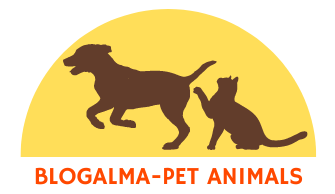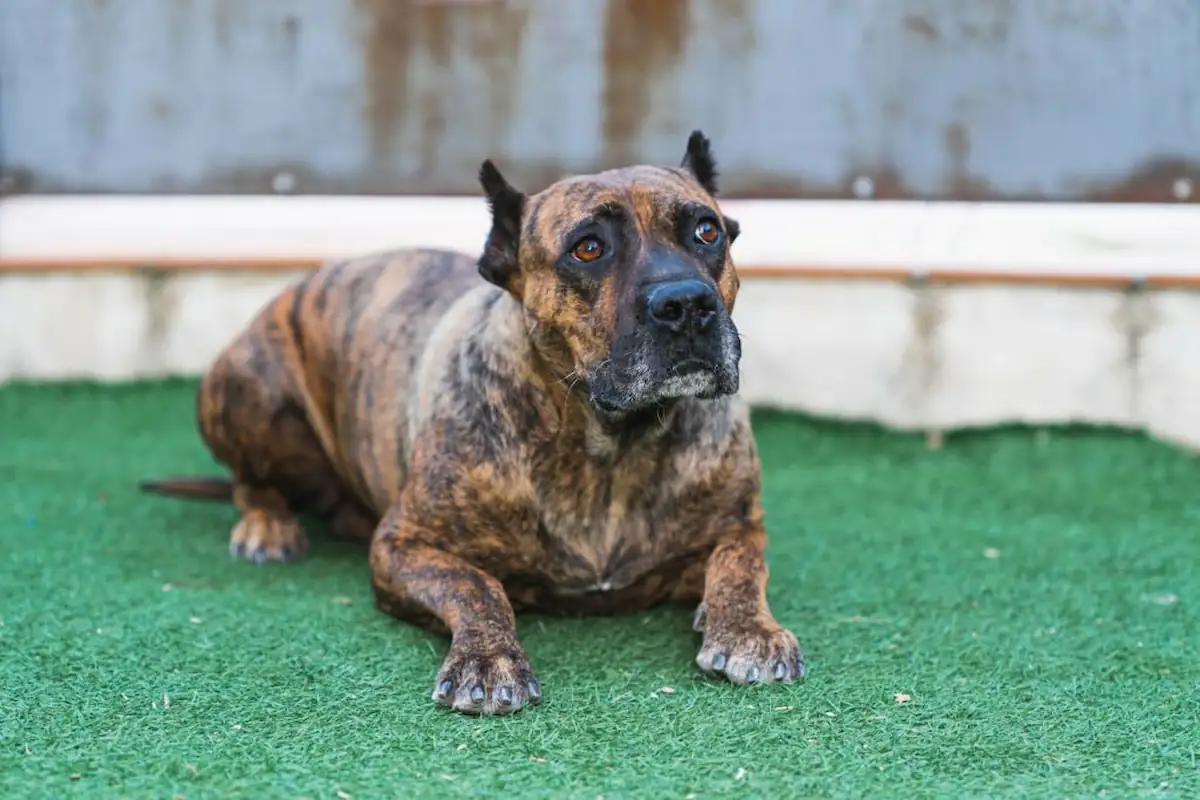A Presa Canario (canario presa dog) is a relatively rare, big-sized, strong, and well-balanced dog in the Molosser family. They’re self-confident, cool, and strong-willed pups and are tops when it comes to guarding things.
Additional names for these dogs are Dogo Canario, Canary Mastiff, Canarian Dogo, and the Canary Catch Dog. These dogs are very peaceful and mind well if with their people. And they are mainly devoted to their owner while being incredibly indifferent and distrustful of outsiders.
These dogs aren’t for everybody and not if you have never owned a dog. Therefore you must be sure it’s the correct breed of dog for you, and you’ll be able to manage it before talking to people who breed Presa Canarios. These dogs are exceptionally dangerous if the wrong people get them. Presa dogs need an owner that knows how to manage their behavior and who’ll give them the correct kind of training and socialization. If they’re raised right, they will be loving of their people in their family.
FUN STATISTIC: Presa Canario dogs can handle heat better than a lot of mastiff-type breeds.
History of the Canario Presa Dog Breed
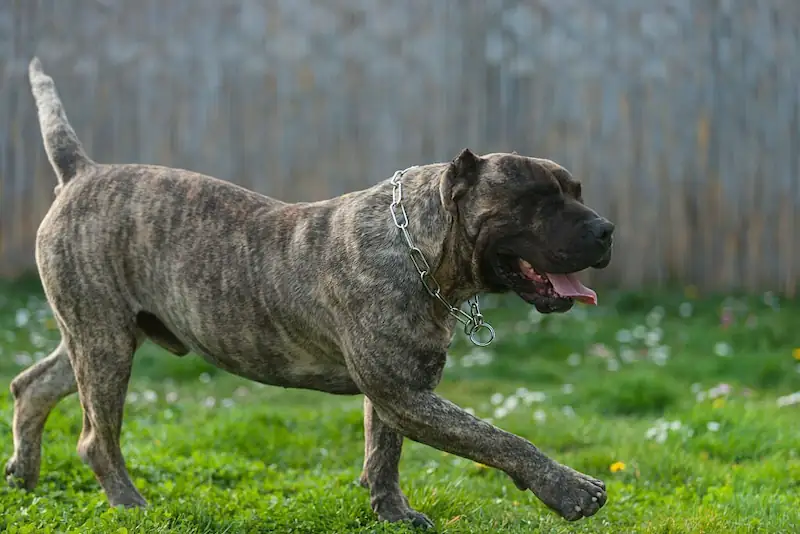
These dogs first were bred in the 1800s in the Canary Islands, which are seven islands Spain owns. A few think mastiff breeds got taken there via the Spanish Conquistadors during the fifteenth century and thus created the kind of Presa Canario dogs we have now.
Presa Canarios came from mixing the Iberian Presa (Perro de Ganado Majorero) and the native Bardino Majorero dog, along with English Mastiffs and several other Hispanic dog breeds. These dogs were designed to be essential farm dogs who did several jobs –Presa Canarios had to be shepherds. They herded cattle; hunted wild boars, feral dogs, and additional wild animals that endangered the cattle.
Since these dogs are courageous, massive, and robust, they’re ideal for fighting. Dogfighting was banned in 1940 dog though they kept on having them for the next ten years. During this timeframe, this breed’s numbers dramatically went down. The decline was due both to the banning of dogfighting and the introduction of German Shepherds, Dobermans, and Great Danes.
Dog lovers were more interested in those dog breeds, which nearly caused Presas to become extinct. During the 1970s, they started to rebuild the Presa breed. Several trustworthy breeders began with giant, energetic, and well-designed dogs and began breeding them. These canines had the instinct to be watchdogs, as well as strong temperaments, and were terrific for protecting their owner’s property.
As of 1982, several breeders started the complete recovery of this breed of dogs and created an association for Spanish Perro de Presa Canarios on Tenerife’s island. Their single objective was to restore this breed of dog.
FUN STATISTIC: Presa Canarios is the animal emblem of Gran Canaria Island, one of the bigger islands that belong to the Spanish Canary Island archipelago.
Canary Mastiffs are quite muscular and robust dogs. Their chest, legs, and neck are powerful. Their body is lengthier than it is tall. Their heads are round and wide, and their jaw is big and powerful.
FCI standard
This breed of dog is in Group 2 (Schnauzers and Pinschers – Molossoid Breeds – Swiss Mountain dogs and Cattle dogs) – Section 2.1. (Molossoid Mastiff types). Male dogs can attain a height of between 23 and 26 inches (which is 60 to 66 centimeters), whereas female dogs get as tall as between 22 and 24 inches (which is between 56 and 62 centimeters).
Male dogs may weigh between 110 and 143 pounds (between 50 and 65 kilograms), while females may weigh between 88 and 121 pounds (between 40 and 55 kilograms). They got identified by the FCI as of 2011 and were called Dogo Canarios. In 2018 the breed’s name got altered to be called Presa Canario.
AKC standard
Completely grown Perro de Presa Canarios can get to be between 22 and 26 inches (same as between 56 and 66 centimeters) tall and may weigh between 84 and 110 pounds (same as between 38 and 50 kilograms). Based on that standard, they are put into the Foundation Stock Service group. This group is a voluntary service for all kinds of purebred dogs the AKC doesn’t register.
Care and Shedding
Presa Canarios have short, smooth coats which are not hard to groom and they sit close to their body without any undercoat. Due to that, Dogo Canarios do not have to be brushed very often. Brushing them weekly is plenty to keep them healthy and looking shiny. But in the spring and fall seasons, they need to be brushed more often because they shed more.
During this timeframe, they must be brushed frequently, or there will be dog hair all over your home. Their coat comes in several colors, such as fawn, silver or red fawn, and brindle shades of red, brown, fawn, reverse, and Verdino. As much as 20 white colorings on their feet, muzzle, and chest are allowed.
FUN STATISTIC: The AKC and the UKC allow black coats to be an official shade, but the FCI does not.
Presa Canarios have nails that grow very quickly. Therefore they must be cut regularly. You also have to clean their eyes regularly to avert potential infection from developing. Clean the ears using a cotton ball that’s been dipped in a pH-balanced ear cleanser. Whenever you brush your dog, check them to see if there are any possible infections or rashes, etc., and that way, you may avoid several serious health troubles if you check your pet regularly.
These pups do not drool as much as the mastiff breed does. Presa dogs do drool after eating or drinking.
FUN TRUTH: Perro de Presa Canarios has a bite force equaling 540 PSI (pounds per square inch).
Canary Mastiff’s Ears
Nearly all these dogs have cropped ears. Presa Canario’s ears were traditionally cropped to avoid damage when they worked to round up cattle and avert tearing their ears up while fighting other animals. Though ear cropping is banned in most countries these days, you rarely see this breed with silly droopy ears. Cropped ears emphasize this dog’s powerful presence.
Training a Presa Canario
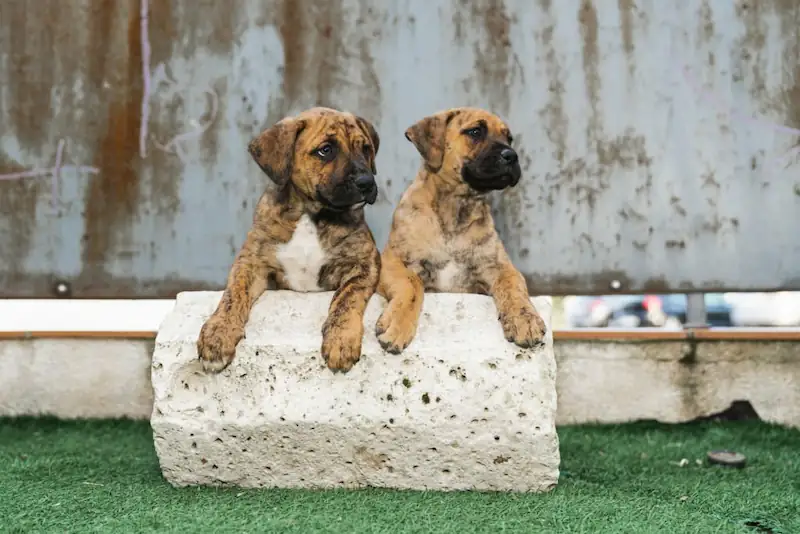
Presa Canarios has a balanced personality and is incredibly self-confident. They must be trained correctly from puppyhood. It would help if you enforced yourself as the alpha in your pack so your dog respects and listens to your commands. They are dominant naturally, so they aren’t a good pick if you have never had a dog before.
Training has to start from the beginning and has to be done consistently. The key to doing effective training is to ensure it is done interestingly and avoid repeating it. Fortunately, these canines are extremely smart and fast learners who react well to using positive reinforcement.
Also vital is to socialize them early on. It would help if you exposed the puppies to all types of varying noises, sights, individuals, animals, and other dogs. Then your puppy will end up as a very balanced adult.
A presa canario can have an extremely high prey drive, and thus are very territorial. Every Presa Canario is born having the instinct to protect things which is why they make an excellent guard dog. If they think their family members are under attack, they will respond and attack the problem’s source. Watching their family and belongings will always be a Presa dog’s first job they want to do. These dogs are loyal as well as loving. These pups are a great option for families who have older kids who understand how to act around large dogs. They aren’t a good pick for a family with small kids since they are massive and may accidentally knock them over and hurt them.
Presa Canario Energy intensity
These pups require lots of exercise! They’ve got lots of energy, so if they don’t get the correct quantity of mental stimulation and the training they need, a Presa will get bored and become destructive. These pups love exploring and roaming around. They aren’t advocating for living in a small apartment. For a Canary Mastiff dog, the perfect living place is a massive house with a big backyard and a secure fence.
Is the Presa Canario dangerous?
Presas are vigilant and loyal pups who are excellent watchdogs. Typically, they’re relatively quiet, but whenever they bark, it doesn’t sound very comforting. Regrettably, Presas has a reputation of being violent (mainly due to their past whenever used in dog fights), although it’s not accurate. Occasionally, a few Presa Canario dogs show aggression, although they are an exception with appropriate socialization and good training.
NOTABLE FACT: These canines are banned in several countries worldwide, including Australia and New Zealand; therefore, if you’re contemplating getting one of these dogs, you have to see if they are allowed where you live.
See Other Mastiffs: All 20 Mastiff Breeds
Health Issues Facing a Presa Canario
Perro de Presa Canarios usually live between nine and eleven years, which is good for most substantial dog breeds. However, they do have a few severe health issues which can make them live a shorter timeframe.
Issues they may be prone to are hip and elbow dysplasia, as well as epilepsy, hypothyroidism, panosteitis (a disorder depicted by lameness and limping), patellar luxation (when the kneecap is dislocated), bloat, arthritis (mostly in elderly dogs), and dilated cardiomyopathy (sickness of the heart muscles).
Presa Canario breeders
Purebred Presa Canarios are considered to be a rare dog breed, and so they are costly. A pup may cost up to as much as $2,000. When the price is added to vet costs, first vaccinations, as well as the yearly boosters, and the high-quality kind of dog food Presas needs, you’ll end up paying a considerable sum of money. When buying a Presa Canario, be sure you are purchasing it from a trustworthy breeder, not from somebody who puts profit above a dog’s welfare.
Though this is a relatively new breed of dog, there are already some “bad” breeders; therefore, you must watch when looking for a Presa dog. “Bad” breeders attempt to get you to buy a Presa mix, guaranteeing you it’s pureblooded. That’s why you must always ask them to see the pup’s parents and all the paperwork from the cynological organizations. Finding a trustworthy Perro de Presa Canario breeder ensures you purchase a puppy that has the top genetic traits available.
If you’re considering buying a dog from this breed, you must not forget the thing this breed was created to do – protecting livestock, dogfighting, and hunting. That means you have to socialize with your pup from a young age since he might attack and chase away other dogs or animals. These dogs can end up exceptionally dangerous in the incorrect hands, so if you have never had a dog before, you shouldn’t start with these dogs. If you’re willing to do the necessary work, you will get a dog who’s well-behaved as well as devoted and loyal to your family.
Eight Facts Regarding canario presa dog
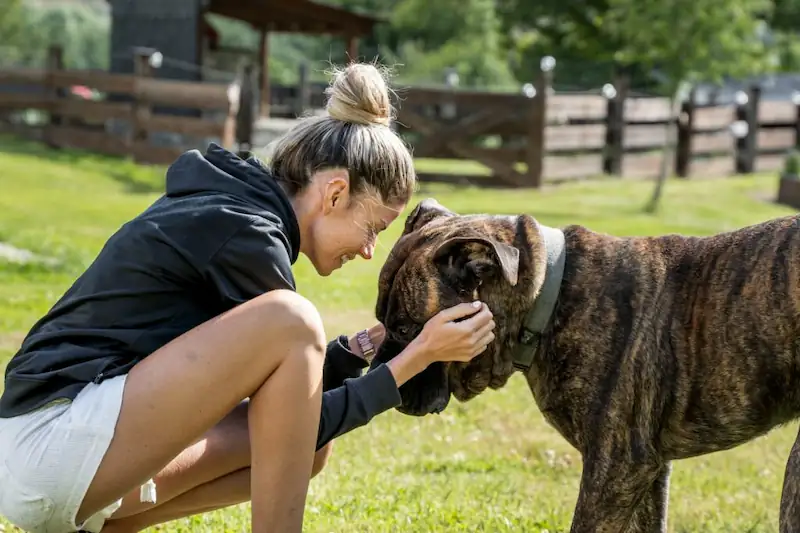
1. The Presa Canario is the symbol for the Canary Islands.
Considering how popular these dogs are, it’s no wonder the dogo canario is the symbol for the Canary Islands.
canario presa dog history is meticulously recorded, conjuring up mysteriousness and awe for this dog breed. This dog breed’s history goes back to the fifteenth century when it was initially transported to the Canary Islands by Spanish conquistadors.
Muscular, courageous, and conscientious, these dogs were bred to work. Island farmers were continually dealing with feral dog packs that attacked their farm animals. The Presa solved that problem and ended up as the supreme protector.
Sadly, it was additionally utilized for dog fights because of its Mastiff strength as well as its clasping genes, which come from Alano, a kind of Bulldog ancestor.
In the middle of the 1940s, dog fights were banned. canario presa dog got regulated to only official breeders to preserve the species.
With careful breeding, Presa Canarios made a magnificent comeback during the 1970s, characterizing itself as being a faithful working dog.
2. The Dogo Canario belongs to the Molosser family.
Molosser dogs are known for their colossal size and strength. A Presa Canario is the embodiment of that, with their thick body and wide square being some of their defining traits.
Whenever the Presa Canario becomes full-grown, it can get to an extraordinary height of 26 inches (same as 66 cm) and weigh as much as 130 pounds (same as 59 kg).
Traditionally a Presa Canario has cropped ears, so their ears will not affect them while working with cattle.
A Presa’s paws look like a feline, and its movement is portrayed as being cat-like. That is additionally a distinctive feature of this breed.
3. Perro de Presa Canarios are fashionable since they don’t shed a lot.
If you are searching for a pup who will not shed fur all over your home, Canario Presa Dog has the exact coat you want.
Their short hair and no accompanying undercoat mean less shedding and simple grooming for Presa Canarios. Brushings once a week are advised to keep their plush coat shiny and healthy.
The colors of the Presa Canario are essential according to their breed standard. It’s okay for them to be brindle or fawn. They can also have about twenty percent white on the muzzle, feet, and chest. The AKC-FSS, UPPCC, and the UKC accept an all-black dog; however, the FCI does not.
4. The Canary Mastiff is incredibly confident.
Perro de Presa Canarios are a breed that has working instincts. It’s instinctively dominant with the possibility of asserting aggression. That is because it was first employed to attack feral dogs as well as protect livestock.
So, when you train Presa Canarios, you must begin their socialization early on and do obedience training starting from puppyhood. If the owner is experienced, these dogs will be brilliant, well-behaved animals that are confident and devoted to their family.
It is peaceful with family members, particularly the main master. However, watch out if you are around different dogs, outsiders, or little kids. That is when its dominating alpha nature manages to show up!
You can’t be awkward around the canary dog. You have to show them you’re the alpha boss. That’s why they aren’t suggested for anyone who has never owned a dog before.
5. Their bite force equals 540 PSI.
That is a powerful bite! How does that compare to other kinds of strong Molosser breeds?
Presa Canario versus the Boerboel
Boerboels (AKA South African Mastiffs) are known to have a potent bite force. That’s due to this giant breed of dog being used in the past to protect livestock in South Africa from lions and hyenas.
With a comparable working background and size, it is safe to declare that it may be a close tie between these two breeds.
canario presa dog versus the Kangal (AKA Turkish Mastiff)
Kangals are the king of dog biters, with an extraordinary bite strength of 743 PSI. This old Molosser breed was produced to endure extreme temperatures and safeguard livestock from bears and wolves.
An unimpeachable watchdog, Kangals will give Presas a run for their money, particularly with a possible weight of 143 pounds (same as 65 kg) and can get to a height equaling 33 inches (same as 85 cm)! This dog is very tough, and you don’t want to get on its wrong side.
Presa Canario versus Cane Corso
Extremely smart and loaded with energy, Italian Cane Corsos have Presas beat since they have a 700 PSI bite. It is an example of one of the strongest dogs in the whole dog world, famous for its enormous size and guarding and hunting abilities.
Like the Presa, this kind of Mastiff requires special training to make sure it grows up to be passive and peaceful as an adult. It conceals an aggressive streak, particularly towards additional dogs or outsiders.
6. Presa Canario’s typical lifespan is 9 to 11 years old.
Canary Dogs are indeed resilient specimens whenever it comes to their working life, which may significantly weaken them or make their lives shorter.
These are the most known Presa Canario health issues you need to know about.
- Hip Dysplasia: Deformity of the hip joint. It impairs their mobility and could cause lameness.
- Dilated Cardiomyopathy: A kind of heart disorder that causes weak blood pumping and weak contractions.
- Mast-Cell Tumors: Might be cancerous.
- Patellar Luxation: An anomaly that triggers the kneecap to get dislocated.
- Epilepsy: Bizarre seizures.
- Osteochondrodysplasias: Developmental disorders that affect the skeletal system, for instance, dwarfism.
7. canario presa dog requires lots of exercise.
Canary Mastiffs are employed outside and can undertake arduous physical activity. Consequently, you may expect a Presa to have tons of energy.
Taking them on a lengthy walk or run daily is sufficient to keep them in top shape. If they do not get enough exercise, a Presa may get bored and end up destructive and chew up some of your valuable property.
Contemplate entering your Presa Canario in a jumping competition. They adore getting a job to do! The breed is well-known for excelling in competitions that test their agility, strength, and obedience. It is another great option for keeping your pup stimulated physically and mentally.
We do not recommend this breed for apartment living with the Canary Mastiff’s size and the amount of activity it needs. It needs space to run and stretch out its long limbs. A house with a fenced yard is the best environment for the Presa.
Feeding period
A Presa Canario must have a well-balanced diet to keep illnesses and obesity from coming on. Speak to your vet to decide the amount of food you ought to feed your dog daily, based on how old it is. Divide their food into two or three meals.
Top-quality dry dog food that includes protein and carbs will ensure your Presa gets lots of nutrition.
8. Presa Canario pups may cost as much as $2,000.
This old dog breed is pricey, although for excellent reasons. Molosser dogs are complicated, mostly due to how large they are their temperament, and their instinct to be watchdog instincts. They have a reputation as dangerous dogs and must also be considered because many places have banned them.
It requires a unique (and extremely responsible) dog owner who can dedicate lots of time and energy to take care of a Canario presa dog pup. Okay, it’s a large, gorgeous dog who will make people look twice, but if that is the sole reason you want to get one, take a little time to do the proper research before deciding.
If you’re passionate about this breed, then if you search for trustworthy Presa Canario breeders, you can be ensured you get a pup with the finest genetic traits achievable.
It is vital to stick to the breeding standard regulations since a pup that comes from a puppy mill in which their genetic makeup is distorted, and the Presa Canario bloodlines are unidentified produces a greater risk of illness and erratic temperament.
Follow these instructions when searching for breeders of Canary Mastiffs.
